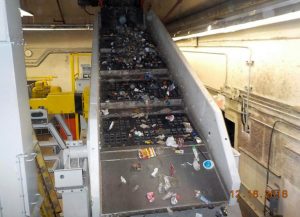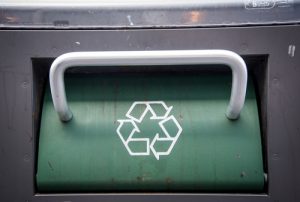
Brent Bell, vice president of recycling operations.
The recycling chief at Waste Management recently reflected on the company’s ongoing efforts to clean up the material stream. The takeaway: It’s a long slog.

Brent Bell, vice president of recycling operations.
The recycling chief at Waste Management recently reflected on the company’s ongoing efforts to clean up the material stream. The takeaway: It’s a long slog.
 Why are paper recycling prices at near-record levels? The answer boils down to uncertainties in the Chinese market and strong demand at home.
Why are paper recycling prices at near-record levels? The answer boils down to uncertainties in the Chinese market and strong demand at home.
 A materials recovery facility spent $671,000 to buy and install glass cleanup equipment, which is generating $296,000 in annual savings. The project in Guelph, Ontario shows how investing in glass recovery technologies can pencil out favorably for MRFs.
A materials recovery facility spent $671,000 to buy and install glass cleanup equipment, which is generating $296,000 in annual savings. The project in Guelph, Ontario shows how investing in glass recovery technologies can pencil out favorably for MRFs.
 The national average price of post-consumer PET beverage bottles has been rising steadily since January. On Jan. 3, the national average price was 10.8 cents per pound and has moved up 39.8 percent to the current 15.1 cents per pound.
The national average price of post-consumer PET beverage bottles has been rising steadily since January. On Jan. 3, the national average price was 10.8 cents per pound and has moved up 39.8 percent to the current 15.1 cents per pound.
 Pennsylvania’s recycling industry contributed $22.6 billion in value to the state’s gross product in 2015, according to an economic impact report. The industry also contributed $1.7 billion in state taxes and $2.7 billion in federal taxes that year.
Pennsylvania’s recycling industry contributed $22.6 billion in value to the state’s gross product in 2015, according to an economic impact report. The industry also contributed $1.7 billion in state taxes and $2.7 billion in federal taxes that year.
 Pratt Industries, which makes paper and packaging from 100 percent recycled materials, last week held a ribbon-cutting ceremony for its latest mill.
Pratt Industries, which makes paper and packaging from 100 percent recycled materials, last week held a ribbon-cutting ceremony for its latest mill.
Apple says it is taking steps to boost its internal recycling efforts after the diversion rate at the company’s non-manufacturing sites fell for the second year in a row.
 Ontario lawmakers last week passed a bill mandating producers to pay the full costs of recycling printed paper and packaging. However, many specifics of the recovery system, which will target a wide range of plastic products, have yet to be determined.
Ontario lawmakers last week passed a bill mandating producers to pay the full costs of recycling printed paper and packaging. However, many specifics of the recovery system, which will target a wide range of plastic products, have yet to be determined.
 Brand owners will have to cut bigger checks over the next year to support curbside recycling in Canada’s most populous province.
Brand owners will have to cut bigger checks over the next year to support curbside recycling in Canada’s most populous province.
 In its first full year of operation, British Columbia’s printed paper and packaging recycling program notched a 77 percent recovery rate, beating the target set by the government.
In its first full year of operation, British Columbia’s printed paper and packaging recycling program notched a 77 percent recovery rate, beating the target set by the government.

